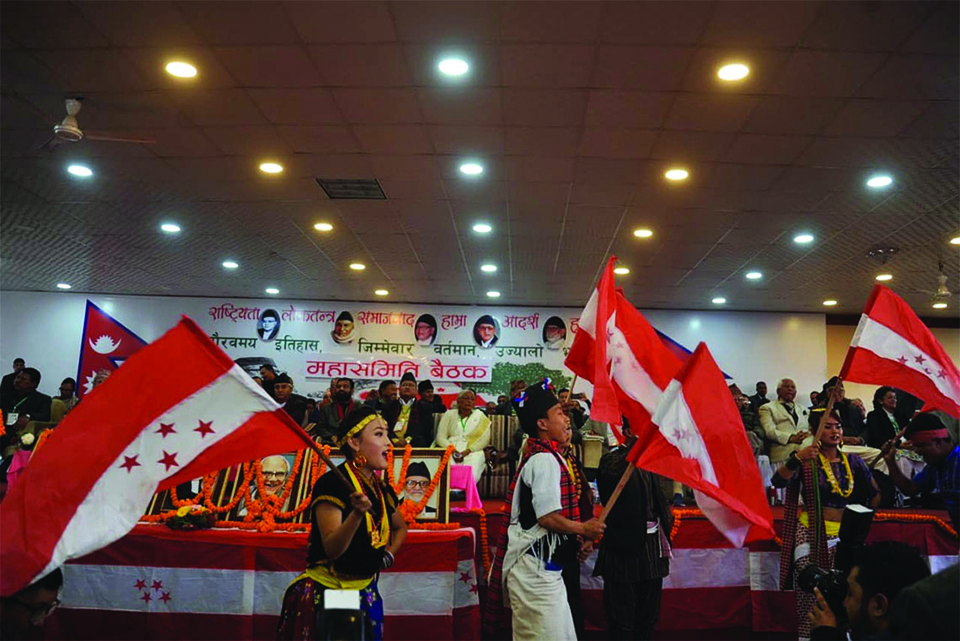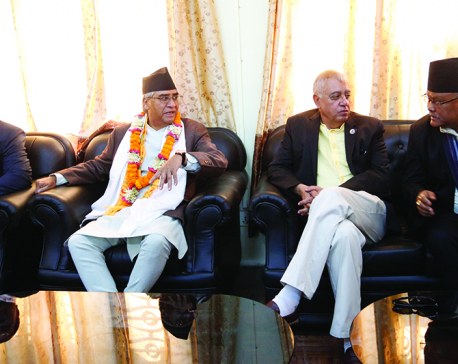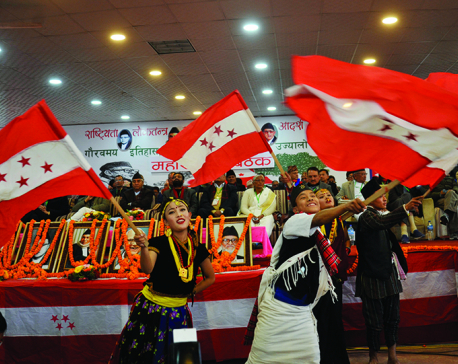
OR

Even though politics of here and now demands repositioning of Nepali Congress, playing to the religious gallery might prove to be irreversible route fraught with perils
In the recent Mahasamiti meeting of Nepali Congress there were murmurs of restoring Nepal back to the Hindu kingdom. Considering that the party has long been a champion of democratic movements in Nepal and has stood as a bulwark against Panchayat system of which Hinduism was one of the pillars, it surprised many political observers. However, there hardly seems to be any consensus in the party about the issue. We have witnessed Bimlendra Nidhi going on record to oppose the invitation of a firebrand Hindu leader from India, Yogi Adityanath to Janakpur on the occasion of Vivah Panchami. Since Nepal already has a far-right party RPP that is clamoring for reversal to Hindu monarchy, NC’s positioning vis-à-vis RPP must be different if it actually supports Hindu state.
Politics of compulsions
NC’s claim has to be viewed from two different perspectives. First, they are struggling to find a strong foothold in domestic politics owing to the unification of Communist parties. Due to strong factional presence the grand old party of Nepal is mired in intra-party disputes and is unable to pose a unified challenge. The party’s image is synonymous with corruption and misrule. Despite the current government’s misrule, most Nepalis don’t buy the claim that they would be better off under NC’s rule. Unable to find a solid narrative against a formidable opposition, it is resorting to the resurrection of religion. Religion matters and in Nepal with about 80 percent population following Hinduism, it is easy to bind people based on god especially against the godless Communists who believe in the cult of Mao, Lenin and Stalin.
Second, there is a rising religious consciousness across the globe and in neighborhood in recent times. Myanmar and Sri Lanka have witnessed the most brutal persecution of religious minorities Rohingyas and Hindus by the majority Buddhist regime. In Bangladesh that was founded as a secular republic, Islamic sentiments are on the rise. Closer home, in India, the ruling Hindu nationalist party BJP flagrantly raises political temperature when its members resort to violent means such as mob lynching to cower the minorities thereby forcing them to live under constant fear. The meteoric rise of BJP in India from two seats in 1984 to 282 in 2014 Lok Sabha elections is a proof of the rise in Hindu consciousness.
Making matter worse, Indian National Congress (INC), whose avowedly secular founders enshrined secular values in the constitution of India, is vying for Hindu votes by resorting to what intellectuals call ‘soft Hindutva’ as opposed to BJP’s hardcore Hindutva ideology. In a bid to reposition the party that is often accused of appeasing to the minorities, the party is playing to the Hindutva gallery albeit in a softer way with the aim of reviving the party’s declining fortunes. In a spillover effect NC, whose founding members were inspired by the liberal and democratic values of the INC and established the party on the similar lines, once again seems eager to tread the similar path.
Secularism retreats
Secularism as a value is the product of the idea of the Enlightenment which helped usher in the Industrial Age. In a war for mind with the forces of religion aligned with the power elites of the agrarian past, secular forces representing industrial “modernism” and mass democracy managed to subdue the organized religion weakening its hold on the state.
As the industrial society grew, market became the focal point and people were sucked into the money system. Economic growth became the primary goal of governments. The acquisition of riches by the rapacious industrial nations served only to stimulate their avarice and they were virtually at war with nature. Progress justified the degradation of nature. With industrialism grew rampant consumerism and material culture ringing true Max Weber’s prediction that the spirit of capitalism was bound to destroy its Protestant ethic parent, as materialism corrupted asceticism of the godly.
By the 1970s, signs of crisis in industrial nations were visible. Its ecological by-product threatened life, basic industries shrank, communities were torn by moral conflict devastated by drugs, crime and family break-up. One hardly needed to be a Marxist to agree with the Communist Manifesto’s famous accusation that the new society “left no other nexus between man and man than naked self-interest, than callous cash payments.” Personal relationships, family bonds, community ties all became tinctured by commercial self interest.
Upset by the break- up of the familiar world, religious fundamentalists began a powerful counter-attack on the cultural premises of the Industrial Age, including their hostility to secularism as the philosophical base of mass democracy that took the form of highly effective political action. Post 9/11, USA and its Western allies have virtually been at war with the Islamic world in a “Us vs Them” conflict that has been caricatured as the “Jihad vs MacWorld”. The core values of the western civilization such as secularism, rule of law, idea of free society, equality of sexes are openly repudiated by the Islamists. These attacks might have carried less punch had the industrial nations not been in moral and social decline.
Mass immigration from the Islamic world to the West has not helped either. There have been cases where immigrant communities have not been successfully assimilated, falling prey to radical ideologues with profoundly destabilizing consequences. The rising Muslim population in Europe due to immigration has led to the warnings by some scholars of a future ‘Eurabia’—a continent Islamicized by the end of twenty-first century. Though the West maintains a veneer of secularism, targeting and demonizing a particular religion doesn’t justify such claims.
Nepal’s context
In Nepal, secularism is increasingly seen as a forced Western value, a tool for the West’s dominance over the rest. It is associated with exploitation and corruption where few ruling elites in collusion with their Western masters promote foreign agendas. Most intellectuals and citizens alike belonging to the majority Hindu community believe that there wasn’t sufficient debate when Nepal embraced secularism abandoning its centuries old Hindu Sanatan Dharma. It was a hurried agreement made by GP Koirala with the aim of mainstreaming the Maoists. The ensuing spiritual vacuum, most complain, leave Nepali society vulnerable to the sinister ambitions of a minority of people who do have religious faith as well as political ambitions to expand the power and influence of that faith in their adopted countries. The burgeoning of churches in Nepal, for instance, is attributed to the pernicious designs of the minority.
The ruling elite of Nepal composed of high caste Hindus nurture grudging resentment against the growing influence of those at the bottom of the caste pyramid. They see the current disorder in the social and political system due to “letting loose” of the masses comprised mainly of low caste and non-caste groups as a manifestation of secularism and at times expresses their deepest anxieties against it.
While deciding its political course, NC will have to ensure it doesn’t deviate too much from its liberal, democratic and pan-Nepal image. Even though politics of here and now demands repositioning the party, playing to the religious gallery may be irreversible route and fraught with perils.
The author is a lecturer based in Rajbiraj
Twitter: @manjeetmishra82
You May Like This

Fractured Nepali Congress
Nepali Congress can salvage its reputation by being true to its traditionally held principles that came in good stead for... Read More...

Opposition is rising
Government should heed the issues raised by the opposition party and work to fulfil the promises made to the people... Read More...

Saffronization of Congress
The liberals, moderates and youth leaders in Congress must safeguard their party against the communal, sectarian allure of right-wing Hindutva... Read More...







Just In
- NRB to provide collateral-free loans to foreign employment seekers
- NEB to publish Grade 12 results next week
- Body handover begins; Relatives remain dissatisfied with insurance, compensation amount
- NC defers its plan to join Koshi govt
- NRB to review microfinance loan interest rate
- 134 dead in floods and landslides since onset of monsoon this year
- Mahakali Irrigation Project sees only 22 percent physical progress in 18 years
- Singapore now holds world's most powerful passport; Nepal stays at 98th












Leave A Comment